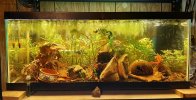Temperature of 26°C is fine.
Other readings:
Nitrogen compounds: Ok, the hongsloi tank is cycled, going by the readings, the hospital tank is not. And if that fish has been breathing for some days in it, it's time for a waterchange due to rising amminia levels.
pH: All as expected.
Hardness: You should really consider getting a test. Although in Canada and Europe most info you get from the water suppliers is correct, often the suppliers' info brochures most often only give the year's average. Depending on the season different sources may be used for the drinking water in the system. E.g. in my tap the NO3 readings swing by more than 20mg/l over the course of the year.
In any case, only if you have solid info about your KH you can actually do something about the pH. Otherwise it keeps being guesswork and assumptions. And those two have killed more fish than any parasite or bacterium.
Other readings:
Nitrogen compounds: Ok, the hongsloi tank is cycled, going by the readings, the hospital tank is not. And if that fish has been breathing for some days in it, it's time for a waterchange due to rising amminia levels.
pH: All as expected.
Hardness: You should really consider getting a test. Although in Canada and Europe most info you get from the water suppliers is correct, often the suppliers' info brochures most often only give the year's average. Depending on the season different sources may be used for the drinking water in the system. E.g. in my tap the NO3 readings swing by more than 20mg/l over the course of the year.
In any case, only if you have solid info about your KH you can actually do something about the pH. Otherwise it keeps being guesswork and assumptions. And those two have killed more fish than any parasite or bacterium.
